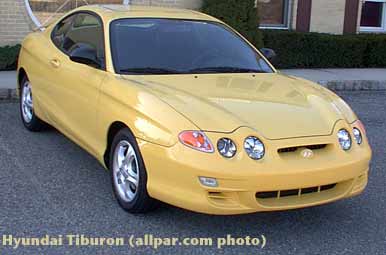 |
| The previous generation, with its more original styling |
Click here for the first-generation Tiburon (through 2001)
| Review Notes: 2002 Hyundai Tiburon V6l | |
| Personality | Economy sports coupe |
| Quirks | Great handling but squeal-prone tires; power lock behavior |
| Unusual features | Acceleration for price (and fuel economy) |
| Above Average | Performance |
| Needs Work In | Ergonomics |
| Bottom-scraper test | Marginal |
| Car reviews written by | David Zatz |
The original Hyundai Tiburon was one of the sleekest sporty cars on the road. Low-slung, graceful, and smooth, it was one nice-looking car. Its looks were complemented by a strong sporty personality, good handling, and an overall sporty feel. The whole package, though, was marred by poor gas mileage, low acceleration, vibration, and noise at highway speeds.
The second generation, still based on the popular Elantra, brings the Tiburon the power and acceleration its sporty looks promised, replacing the 140 horse four with a considerably more efficient, and quieter, 181 horse V6. Vibration is pretty much gone, and the Tiburon feels much more advanced. However, the interior is less friendly, and the looks are arguably less attractive. The Tiburon has been reshaped to look more like a Cougar or Celica.
The interior is fairly quiet, with just a hint of the Tiburon's well-tuned exhaust note coming through, and relatively little wind noise. It is, for the most part, nicely designed, with generally easy to use controls. At night, the instrument panel has amber backlighting, which is easy on the eyes and preserves night vision.
The engine now has enough power to match the car's sporty appearance and impractical interior, though there's not much torque available right off idle. It almost acts like it has a turbocharger, in that power comes on rather suddenly. Once off and running it is quite fast; magazines have tested zero-to-sixty acceleration at just a little over seven seconds, which is quite respectable for a four-passenger car that has a large trunk and a sticker price of under $20,000. We'd like to see it go up against the Neon R/T (which won Grassroots Motorsports' small-car shootout) one of these days.
Our vehicle had the optional six-speed manual, geared for fuel economy on the highway or high speeds (your choice) in sixth gear. The clutch seemed to stutter, but we suspect the issue was a rough-idling engine, which could have been caused by a prior driver getting a bad tank of gas. We appreciated the relatively gentle cutoff when we hit the redline; rather than jarring us by shutting off fuel entirely, it simply stopped any further acceleration.
Though handling is good, the tires have a tendency to sqeal too readily on turns where there should be no noise at all. The ride is firm, but not bone-jarring. Brakes are up to par.
Low seats and low ceilings still force the driver to recline or hit the roof, but there is room for four people - though low headroom in the back and an overly large hatchback led Hyundai to put in a warning label so you don't hit passengers in the head when closing the hatch. We found that the only practical way to use a baby seat in the rear was to climb into the trunk area and lower the baby in that way; getting into the back is rather difficult with or without a baby. Fortunately, most drivers probably won't carry four passengers most of the time, and the rear is large enough for kids in booster seats. The seat folding mechanism seems to have been redesigned for easier use.
 |
| The previous generation, with its more original styling |
The interior includes an overhead rack for sunglasses, map pockets, and a small center console. The controls are all easy to understand, and the silver-on-black look is no longer over the top. Buttons and levers have a solid feel, and all controls are well labelled and sensibly placed. Our test car had silvered pedals and large silver rings around the tach and speedometer, with metal accents on the shifter, with no TT-like kitsch. The Tiburon keeps power supplied to the windows and radio after you take the key out, shutting it when you open the door. Speeking of the radio, our test car - which cost a bit over $21,000, all told - included an Infinity stereo system with speakers that would not be out of place in a living room. The bass response of this system is enormous, while stereo separation is assured for the front passengers with carefully placed tweeters. The stereo itself is double-sized for easier control.
The headlights are surprisingly powerful, better than most other cars on the market. The low beams have a sharp cutoff to avoid blinding other drivers, and stay on when the high beams are activated. The high beams cover the entire road well. Fog lights are where they should be, down low and aimed correctly for penetrating fog instead of other drivers' eyes.
For most buyers, the key issue in buying a Hyundai is quality, but all indications are that Hyundai has finally reached acceptable standards, rivalling Mitsubishi and Ford in the middle of the pack rather than Land Rover and Hummer far below the bottom of the pack. Hyundai's warranty includes five year bumper to bumper and ten years of drivetrain coverage.
While the Tiburon is fun, it is not the most practical car on the planet. It is more fun and far more drivable than the Toyota Celica, but the Dodge Neon R/T offers similar performance with more comfort and interior space. The Mitsubishi Eclipse is also a worth opponent - as is a used Camaro, which is a formidable machine even with its base V6. While we appreciate the added engine performance, we miss the look and feel of the original Tiburon.